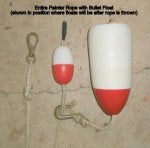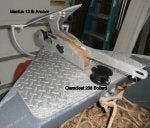I have such a set up. I have a jam cleat mounted on my gunnel near the back of the canopy. I use a 25 foot piece of floating rop ( a painter), you can use Poly or West Marine has a hybrid floating rope stock that is more abrasion resistant. I spliced an eye in one end of that rope. I attached a small float, an A2, I believe, near the splice end, with a figure eight knot behind it to keep it from moving. I zip tied the float to the rope. The float suspends the anchor rope bag, which will sink if you have nylon rope like I do.
The anchor rope is managed using the standard rope bag that Bob's and fisherman's sell. I tie off the bag per the instructions, and then tie the knot in this article
by Gundog ahead of the anchor bag (towards the anchor). I clip that knot to the spliced loop in the short rope. The bag will hang from the knot, and tension flows from the knot to the painter.
I have a second jam cleat near the front of the boat. When anchoring, we get the anchor set, tie up the rope bag in the right spot, then the rope bag and small float go over the bow into the water, and the painter gets tied off in the front jam cleat. We cleat the rope to the first jam cleat on the bow, and throw the rope over the side. It drifts back, we pick it up, put it in the back jam cleat, and undo the front cleat. The boat is now tied off by the back jam cleat. When you get a fish, you pull the rope from the back, it slides up through the bow chock, and we drift out.
I do not use an anchor nest. You need something to contain the short rope on the bow. Some guys modify their nest, I use an older style bow chock that you can get at Fisherman's or West Marine. CCW milled a notch into his nest.
This is the rope I use for the tie off rope. It's good stuff for this use. I used 1/2 inch, 3/8 works too, but half inch is easier on the hands.
Hope that helps. It's really handy and slick.






















